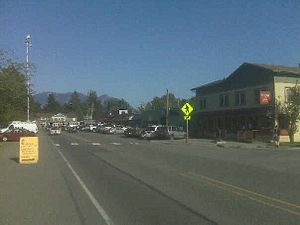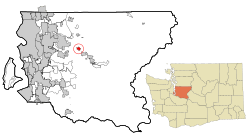Fall City, Washington facts for kids
Quick facts for kids
Fall City, Washington
|
|
|---|---|

Downtown Fall City, 1999
|
|

Location of Fall City, Washington
|
|
| Country | United States |
| State | Washington |
| County | King |
| Established | 1856 |
| Government | |
| • Type | Unincorporated area |
| Area | |
| • Total | 2.90 sq mi (7.51 km2) |
| • Land | 2.84 sq mi (7.35 km2) |
| • Water | 0.06 sq mi (0.14 km2) |
| Elevation | 105 ft (32 m) |
| Population
(2020)
|
|
| • Total | 2,032 |
| • Density | 716.91/sq mi (276.80/km2) |
| Time zone | UTC–8 (Pacific (PST)) |
| • Summer (DST) | UTC–7 (PDT) |
| ZIP Code |
98024
|
| Area code(s) | 425 |
| FIPS code | 53-23200 |
| GNIS feature ID | 1531451 |
Fall City is a small community in King County, Washington, United States. It's located about 25 miles (40 km) east of Seattle. The community sits where the Snoqualmie River and Raging River meet. In 2020, about 2,032 people lived there.
Contents
History of Fall City
Fall City has a long and interesting history. The first settlements in the area were two forts built in 1856. This was during the Puget Sound War. The forts were meant to protect settlers from possible attacks by local Native American tribes.
Early Settlements and "The Landing"
The forts, named Fort Patterson and Fort Tilton, were built with help from Native Americans led by Chief Patkanim. However, the tribes remained peaceful, so the forts were left empty within two years. You can find a historical marker for Fort Tilton north of Fall City today.
In 1869, a trading post was set up near where the Last Frontier Saloon is now. This post became a central spot for the local economy. At that time, Fall City was known as "The Landing." This was because the shallow water and fast-moving parts of the Snoqualmie River made it hard for large dugout canoes (boats made from hollowed-out tree trunks) to travel further upstream.
In the early 1870s, the first local mill in the Snoqualmie Valley opened. It was located near Snoqualmie Falls, just upstream from where Fall City would grow. The Fall City post office officially opened on June 10, 1872.
Railroads and Growth
Small steamboats started carrying supplies up the river in 1875. In the late 1880s, a group of business people began building the Seattle, Lake Shore and Eastern Railway. They planned a train line through the Snoqualmie Valley to cross the Cascade Range.
A man named Jeremiah "Jerry" Borst owned the land in Fall City. He had the town mapped out, expecting many people to arrive with the railroad. However, in 1889, the train line was built about a mile (1.6 km) away from the community.
Even though the railroad was a bit far, it still helped Fall City a lot. Along with the first bridge over the Snoqualmie River, it made it easier for local lumber mills and farmers to do business. It also made the area and its beautiful spots, like Snoqualmie Falls, easy for tourists to visit. Hundreds of people moved to Fall City over the next 20 years.
Modern Development
In the early 1910s, the Sunset Highway was improved. This road connected Seattle with eastern Washington and passed through Fall City. This improvement helped the area grow even more, both economically and in population. By the late 1920s, many people in Fall City worked in tourism or traveled to nearby towns like Issaquah and Seattle for work.
During the tough times of the Great Depression and World War II, tourism in Fall City slowed down. After the war, a major highway (now Interstate 90) was changed to bypass Fall City and Snoqualmie. This also hurt the local economy, and many logging mills closed.
Today, Fall City is a bedroom community. This means many people who live there travel to work in the high-tech industry in the Seattle metropolitan area. You can see large modern homes next to the older, historical houses and farms from Fall City's earlier days.
Geography and Climate
Fall City is located in the middle of King County. It's right where the Snoqualmie River and the Raging River meet. These rivers can sometimes flood during the autumn and winter months.
The area of Fall City is about 2.90 square miles (7.51 square kilometers). Most of this is land, with a small amount of water from the rivers.
Local Weather
Fall City has a mild climate. This means there aren't huge differences between the highest and lowest temperatures. It also gets enough rain throughout the year. According to climate experts, Fall City has a marine west coast climate. This type of climate is known for its cool, wet winters and warm, dry summers.
Population and People
| Historical population | |||
|---|---|---|---|
| Census | Pop. | %± | |
| 1980 | 1,528 | — | |
| 1990 | 1,582 | 3.5% | |
| 2000 | 1,638 | 3.5% | |
| 2010 | 1,993 | 21.7% | |
| 2020 | 2,032 | 2.0% | |
| U.S. Decennial Census 2020 Census |
|||
In 2020, the population of Fall City was 2,032 people. There were about 752 households, which are groups of people living together.
Most of the people in Fall City are White (about 80.4%). Other groups include people of two or more races (6.7%), Asian (1.9%), Native American (1.1%), and Black or African American (0.3%). About 9% of the population is Hispanic or Latino, who can be of any race.
About 23% of the residents were under 18 years old in 2020.
Education in Fall City
Students living in Fall City attend schools that are part of the Snoqualmie Valley School District.
There are two schools from this district located right in Fall City:
- Fall City Elementary School
- Chief Kanim Middle School
Transportation
Fall City is divided by State Route 202. This highway goes through the Snoqualmie Valley, connecting towns like Woodinville and North Bend. Another road, State Route 203, connects Fall City to Duvall and Monroe.
The community has some public transportation. Snoqualmie Valley Transportation runs a shuttle bus service. This shuttle goes from North Bend to Duvall and is supported by King County Metro.
There is also a small private airport called Fall City Airport. It's about 2 miles (3.2 km) east of Fall City. The airport is owned by a group called the Fall City Airport Association and does not have an air traffic control tower.
See also
 In Spanish: Fall City (Washington) para niños
In Spanish: Fall City (Washington) para niños

